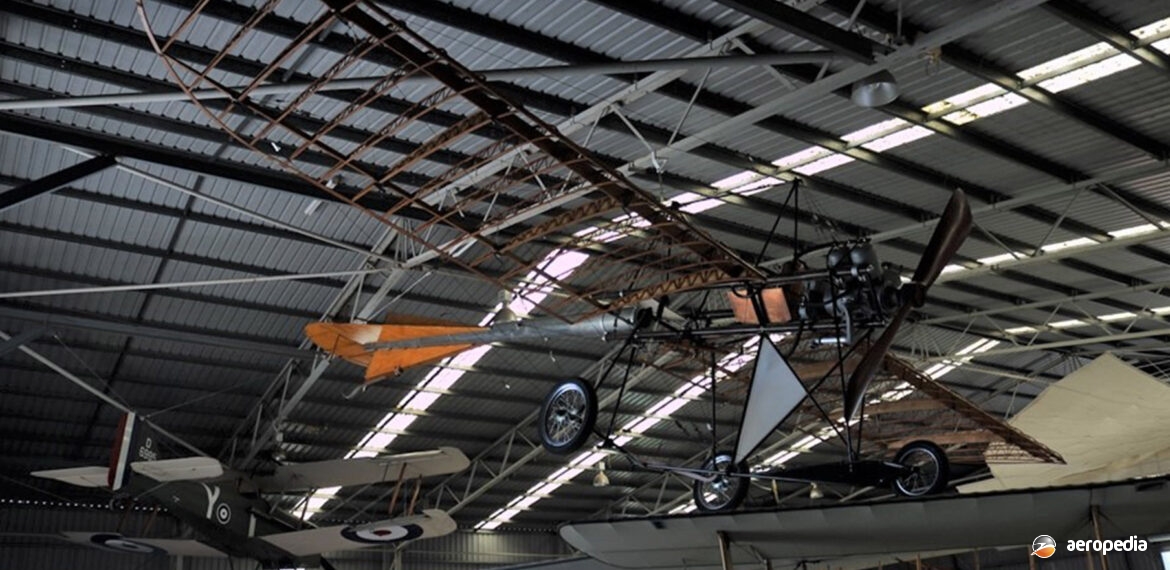Photograph:
Replica of the Johnson Brothers Monoplane at Caboolture, QLD after assembly in 2021 (Eleonore Eyre)
Country of origin:
United States of America
Description:
Single-seat monoplane
Power Plant:
One 48 kw (65 hp) Johnson four-cylinder two-cycle VEE engine
Specifications:
- Wingspan: 10.97 m (36 ft)
- Length: 10.36 m (34 ft)
- Weight: 340 kg (750 lb)
History:
The Johnson Brothers Monoplane was built some few years after the Wright Brothers first flew. In 1919 ‘Janes All the Worlds Aircraft’ reported that no less than 2,000 people in the United States had built flying machines, the majority of which were home-made copies of standard designs, many of them similar in appearance to the Wright Brothers biplane, but not many were particularly successful. In the town of Terre Haute in Indiana in 1911 two different designs were produced, one by the Johnson brothers (Louis, Harold and Julius), and one by Gus Riggs. The Johnson brothers went on to become very successful in the business world, forming the Johnson Motor Company, producing motors for boats and taking away market leadership which, up to then, had been held by Evinrude Motors.
Johnson Motors began as a family owned company in 1908. Louis Johnson was the oldest of seven children born to Soren and Bertha Johnson and in 1903 he conceived building a motor for his 5.48 m (18 ft) boat called the ‘Arrow’ as he had to row it 16 km (10 miles) upstream. His first engine was a 2.2 kw (3 hp) single-cylinder, two-cycle, unit which weighed 68 kg (150 lb). He and his brothers then went on to build two and four-cylinder in-line engines and tested them in a boat named ‘Black Demon’.
They later developed a two-cycle four-cylinder VEE liquid-cooled engine which produced 48 kw (65 hp). This engine was far and away ahead of its time and had a patented valve arrangement. Although said to produce 48 kw (65 hp) some reports indicated it produced the same power as the Curtiss OX-5, 67 kw (90 hp). This was a very lightweight engine for the time and was completed in 1909, about the time the aircraft was built.
The brothers had decided to build an aircraft in which to install the engine for testing. They then built the first monoplane to actually make a flight in the United States. The aircraft became quite successful and invitations were received to convey it to country fairs and carnivals to give demonstrations, a charge being made to examine the aircraft.
This aircraft when constructed was found to be tail heavy and the wooden rear fuselage was replaced with another built from duralumin. They also used nickel and steel in the construction. The aircraft had a steering wheel operating the wing warping which, when moved forward and aft, operated the elevators, with a rudder bar to activate the rudders. It is interesting to note the main fuselage tubes were approximately 6.35 cm (2½ inches) in diameter and had cooling fins along their length. These tubes were used as the radiator in order to reduce the frontal area.
The aircraft first flew in 1911. Louis Johnson, who planned to keep the three wheels on the ground at all times, described the first flight as follows: “but the machine jumped to about 15 m (50 ft) in the air. With the end of the field close, and wires ahead, I shut the motor off by the switch, made a rough landing bouncing up about 8 m (30 ft), and down just in time to avoid a smash-up. There was no damage to the plane which proved its strength.”
The machine was flown regularly on demonstration flights and public displays, surviving for three years with no damage. It was the first aircraft to use duralumin as its primary material, also being the first aircraft to be fitted with a tricycle undercarriage and a brake. However, as Indiana was a long way from what would be termed the aviation world at that time, it was not put into production and eventually was placed in storage in a barn when the brothers turned their attention to a more lucrative market, motor boat engines. It is believed to have slowly rotted away there and none of it survived.
Subsequently the brothers for many years produced and sold various types of marine motors for all manner of motor boats. However, in the meantime, on Easter Sunday in 1913, a tornado destroyed the Johnson factory and, as insurance had not been taken out, the company folded. A new company known as the Johnson Motor Wheel Company was formed and eventually production moved to South Bend in Indiana but this company also folded due to the onset of the recession in 1921.
The brothers then went back to building motors for boats and built the prototype of an outboard motor. This was produced for the American market from 19 December 1921, being constructed from aluminium alloy, producing 1.49 kw (2 hp) and weighing 16 kg (35 lb).
A scale model of the Johnson Monoplane was built in the United States and presented to the Smithsonian Institute in Washington, the brothers being interviewed at that time by Dr Paul Garber in relation to the design and development of their aircraft. As the original plans for the aircraft had been destroyed, they produced new plans for posterity.
In the 21st century Herbert Seizer in South Africa built a full-scale replica of the Monoplane. In 2014 this replica was donated to The Australian Vintage Aviation Society (TAVAS) and shipped to Caboolture, QLD, where it underwent some restoration work and was placed on display.

